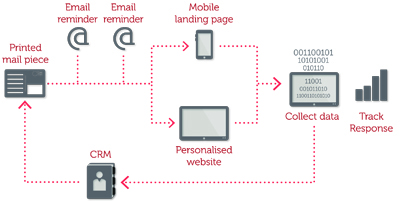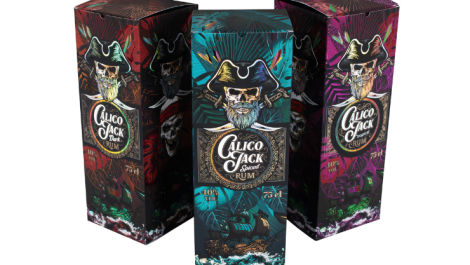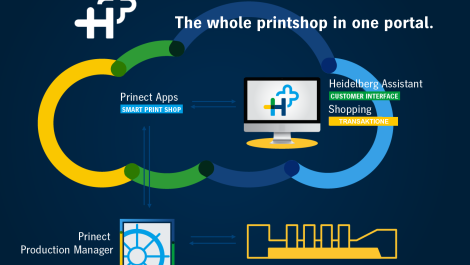A campaign workflow set up in EFI’s DirectSmile. The forthcoming v8 will make this easier to do.
Multi-channel marketing software has been something of slow-burn technology, but with the rise of social media and impending European privacy legislation, it may be about to get a second wind, finds Michael Walker.
No one’s impressed any more by seeing their name formed by puffy clouds against an azure sky or written in the sand of a paradise island beach. Canny consumers are just as turned off by gimmicks in print as they are by spam email or intrusive online ads if the subject matter isn’t pertinent to their situation and interests. Perhaps because of this focus on bells and whistles the whole idea of multi-channel marketing hasn’t caught on with printers as well as its proponents might have hoped.
Christoph Clermont, director of engineering for EFI’s DirectSmile software (and one of the founders of the eponymous Berlin-based company prior to its acquisition in 2014) admits that adoption has been quite slow, and puts this down to printers saying “I can’t sell that, the customer doesn’t have that problem”.
But, he adds, ‘a lot of companies have data and want to do something. Printers are a good group to help, they’ve learned to use complex machines and processes, and they’ve had to be very efficient to survive.’
EFI is working towards a major new release of DirectSmile early in the first quarter of 2018. The major focus of the new version is on making it easier and more powerful to use, both in the campaign design and workflow stages. Rather than presenting users with a blank screen to begin planning, DirectSmile v8 will offer an industry theme-based approach that users will customise to suit their needs. The ideas is to be ‘quick in presentations [to clients], making the first step easier. We give the printers the tools to get into [those] discussions,’ says Mr Clermont.
Again, again
Another key aspect of DirectSmile, though not entirely new, is the idea of reusable campaign assets, and that campaign resources can be used to create recurring revenue for customers. The next release of DirectSmile will build on this idea and make it easier to maximise those resources.Integration with other EFI components, particularly Digital StoreFront web-to-print software and via that to one of EFI’s MIS offerings, allows DirectSmile users to offer a ‘campaigns on demand’ service to their customers, providing both the interface to design and order and the infrastructure to produce and deliver them.

Ricoh is supporting Alzheimer’s Research UK with the Printed Memories campaign in which donors can upload images and have printed postcards of their family memories to share – Still courtesy of Alzheimer’s Research UK, www.alzheimersresearchuk.org
Improved ease-of-use is also a key driver for Objectif Lune, both in its PrintShop Mail variable data print software and particularly its Planet Press suite that supports customer communications management in transactional mail. The software enables printers to offer their customers production services via a newly developed print ‘driver’ – offered via digital press vendors partners – that can send a job to a server rather than to a print device within their own premises; this enables printers to consolidate ad-hoc mail work from multiple sources that would otherwise be unprofitable to handle.
‘The driver can trigger the web browser for a job preview for design or modification, adding mail marks, for example,’ explains Floris Dansen, Objectif Lune’s product line manager, who adds that it’s equally applicable in internal CRD applications.
A customer communications preferences dashboard will be supported in a forthcoming release of the software, allowing email, print or web portal-based communications. This is already supported by pre-made modular solutions that can be downloaded and installed, adding extra channels to the print capabilities that users already have without needing to acquire specialist IT skills. This means that ’email need no longer be a threat; print service providers can deliver at a lower cost and with a higher margin,’ says Mr Dansen, though he admits it ‘requires some change of mindset’ to do this and that many printers are happy to use PrintShop Mail which continues to do the job they bought it for.
David Baldaro, product marketing manager for XMPie agrees that growing the uptake of multi-channel is ‘still a laborious process’, but says that ‘people are starting to connect the dots.’ He notes that the forthcoming GDPR regulations (see Digital Printer September p27) ‘come up in every conversation’, adding, ‘Once you get past the hype, it’s a long overdue update that gives digital printers a huge opportunity as they are predominantly processors of data through VDP, cross-media or multi-channel work. If you have a legitimate interest you can still talk to consumers; direct mail will see a huge surge in the next 12 months as a means to re-engage with customers and get their consent and combine with digital channels to start conversations.’
Chat-up line
Mr Baldaro also thinks social media is going to be key over the next couple of years: ‘It’s currently siloed between the different platforms, though they can increasingly interconnect; XMPie can grab data and use it intelligently via APIs,’ he says. Through integration with chatbots, he explains how XMPie can be used to provide the instant response that users have come to expect.
‘You can jump from a Facebook conversation to a personalised campaign page, driving conversations and providing “instant gratification”,’ he expands, adding, ‘In many cases these conversations can also drive print, which is more trusted than email or websites and can be produced just as easily’.
Since Ricoh acquired US developer PTI Marketing Technologies exactly three years ago, comparatively little has been heard of the products, but a recent visit to the company’s Customer Experience Centre in Telford shows that they are very much alive and well.
The Marcom Central line is now described as “web-to-print marketing asset management”. Mostly aimed at corporates, it enables business rules to be applied to document composition so that terms and conditions are always included as the last page in a proposal, for example, and controls the level of access and editing/content control that different users have – resellers might have a variable field for a “virtual” business card.
Software product manager Mark Ridgeway describes this as “controlled creativity”, supported by a “jukebox” of document templates that could carry different text and images to address different markets, while still ensuring that necessary regulatory information was included or inappropriate combinations of content excluded.
According to Simon Tapley, manager, Software & Workflow Solutions, the opportunity here for print service providers is to manage marketing assets and production on clients’ behalf as a value-added service. The possible downside is that ‘clients may not use the print aspect; you could create variable templates for them in-house where ‘print” could actually be a digital channel,’ he warns, adding, ‘printers need to have someone who can sell this kind of service.’
Marcom Central is being used by Ricoh to support a campaign for charity Alzheimer’s Research UK. Called “Printed Memories”, for a donation of £1 (that will all go to the charity), people can create and print personalised postcards from family photos, which have been shown to evoke memories in Alzheimer’s sufferers. Marcom Central will link with the Avanti MIS (also owned by Ricoh since January 2017) and the postcards will be printed by Ricoh and mailed to the donors.
Making memories count
Marcom Central includes Fusion Pro, which is available separately as a desktop application, Fusion Pro Creator. This costs around €1000 and can also plug-in to Adobe InDesign for and drives personalised print from PDFs, including QR codes. Fusion Pro Producer is a “commercial strength” version suitable for mailings in the thousands-to-millions range, while Fusion Pro Server is an API version that can be integrated into e-commerce websites such as those selling photobooks. Fusion Pro is best established in the US, but Ricoh is now starting to promote it in Europe, for applications such as clothing or retail shelving labels, where it can add barcodes and UPCs.
The technology is clearly mature but it’s also clear that to use it to develop new lines of business that tie clients more closely into print service providers, the latter may have to adjust their thinking – and perhaps their staffing – a bit and realise that they are selling communication services, not press time.





